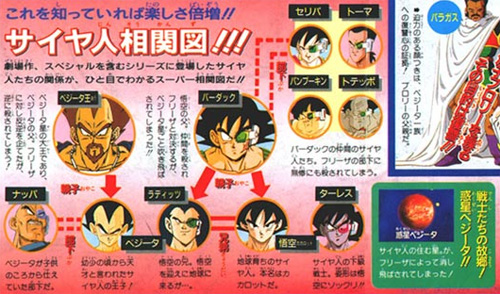Goku and Tullece Are Brothers
The two characters look identical, and with early fansubbers not being expert translators, one can imagine how there came to be vast frustration and confusion over the origin of Tullece. In the third Dragon Ball Z movie, Tullece states that there “weren’t that many types” of “expendable lower-level warriors” like themselves. This does not mean they had the same parents; rather, it seems to suggest that there were many other similar-looking Saiyans (remembering that statements made in movies do not necessarily relate to the facts and events shown in other continuities).
Tullece also explains that they should fight on the same side, since they have the same background; however, there is absolutely nothing in the dialog that even remotely suggests that they are of any actual blood relation.
The film’s theatrical attendee book — covering the Dragon Ball Z film alongside animated adaptions of Akira Toriyama’s Pink and Kennosuke-sama — contains a special “Secrets of the Saiyans” column, which is explicit in its explanation of why “Kakarrot” and Tullece look similar using Tullece’s own in-movie explanation as its basis:
さらに階級ごとに別々の育てられ方をしいるため、同じ階級の者は同じ顔になってしまう。サイヤ人の生き残りであるターレスも、もとは下級戦士。それで同じく下級戦士だった悟空と、そっくりの顔をしているというわけだ。
Furthermore, Saiyans are forcibly raised differently based on their rank, so those of the same rank come to have the same face. Tullece, one of the surviving Saiyans, was also originally a low-ranking warrior. That’s why his face is the spitting image of Goku, who was also a low-ranking warrior.
Unfortunately, at least one bit of Japanese reference material commits a grave error regarding this character: one of the original test-run issues of Shueisha’s V-Jump magazine. The first page of the issue is a fold-out promotion highlighting the upcoming March 1992 Toei Anime Fair, which was set to debut the sixth theatrical Dragon Ball Z film alongside entries from the Magical Taluluto and Dragon Quest series. The Dragon Ball portion features villains from three previous Dragon Ball Z films — Tullece from the third, Slug from the fourth, and Coola from the fifth — with vague promotional text hyping up the (undisclosed) villain in the next film. The text accompanying Tullece states:

孫悟空の兄も敵で登場した。
Son Goku’s older brother also appeared as an enemy.
There is zero ambiguity behind the intent of 兄 (ani) as “brother” in this statement… despite it being incorrect! The error is a strange one, considering the film had debuted well over a year earlier and would have been known and documented.
One major source of confusion has been the UK release of the third Dragon Ball Z movie, entitled Super Battle In The World. While this is indeed an official, English-dubbed release of the movie, it is not a particularly accurate release of the movie, and was not produced by any of the regular companies many fans have since become familiar with. Produced by the AB Groupe and distributed by Warner Vision International, this release of the movie features dialogue that flat-out states that Tullece (or “Tales” or “Turles” or even just “Terlz” depending on which character is speaking) is related to Goku. While one of his henchmen states that their upcoming new power is all thanks to the fruit of the tree, this particular dubbed Tullece states:
“No… thanks to my idiot brother. Heh!”
(Incidentally, later in the same dub of the same film, the character also more accurately states: “It should be no surprise that he and I are practically identical; we come from the same world.”)
Many English-speaking dub fans would swear up-and-down that the character stated they were brothers in the movie, while other English-speaking dub fans would equally swear up-and-down that such a line was absolutely never spoken. These fandom conversations apparently never come to a point where someone happens to mention that they are watching a different English dub from the other person.
Another country that further complicates the issue is France. The aforementioned English dub is actually based on the French translation of the film, which is likely the original source of confusion in the first place:
“Non. Grâce à mon imbécile de frère, non.”
“No. Thanks to my idiot brother.”
Separate from (and simultaneously courtesy of) the film’s dub, the word “jumeaux” has been used in reference to Tullece and Goku. In particular was the 1995 debut issue of a magazine called simply Jam, which had a character relation chart that used this word to describe the two characters. Unfortunately, this word typically applies to biological twins, when in the case of these characters it is more along the lines of a doppelgänger with no evidence what-so-ever of biological relation.
For further evidence, see this supplemental image from the Dragon Ball Z Movie 7 “Film Anime Comic”:
This Saiyan family tree showcases the various fathers and children we had known up to that point in time as of the book’s release. There are also indications of subordinates (buka) with the dotted lines; note Tullece off to the side with no family or subordinate relationships.
Beyond the one instance of V-Jump promotional splash text clearly in the wrong, consider the rest of the dialog and statements as official indication from Toei, themselves, on their own character. In a dramatic sense, their identical character designs are simply a plot device to show the “other” side of Goku: a literal representation of what he could have become without his human influence. Let us rejoice that Goku had that terrible fall and hit to the head as a child; we could have had identical Saiyan terrorists! Well, at least in some alternate timeline…






